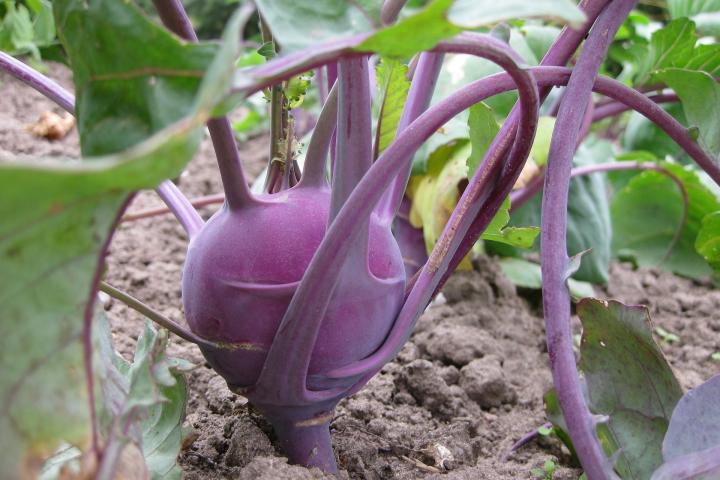Square Foot Gardening Kohlrabi Spacing
Growing Kohlrabi
Planting, Growing, and Harvesting Kohlrabi
Planting, Growing, and Harvesting Kohlrabi

Share:
These Sputnik-shape vegetables may look alien, but their fast growth and great taste make them something every gardener should try in their garden. Here's how to plant, grow, and harvest kohlrabi!
About Kohlrabi
A cool-season biennial and member of the Brassica family (alongside broccoli, cabbage, brussels sprouts, and many others), kohlrabi is grown for its nutritious, bulb-shaped stem. The stem is crisp, sweet, and tender, making it a great addition to salads or stir-fries. In terms of taste, think of kohlrabi as a milder turnip.
Given the right conditions, kohlrabi is easy to grow, matures quickly (in as little as 6 weeks), and is generally pest-free. Give it a try!
Planting
When to Plant Kohlrabi
- Kohlrabi is a cool-season crop, so it is best grown in the cooler weather of spring or fall. In warmer regions such as the southern U.S., it may be grown as a winter crop, too.
- For an early to mid-summer harvest, sow kohlrabi seeds indoors in early spring, 6 to 8 weeks prior to your last spring frost date. Stagger plantings every 2 to 3 weeks for a continuous harvest. Harden off seedlings before planting outdoors, too.
- Alternatively, sow seeds directly into the garden once soil temperatures have reached at least 45°F (7°C).
- For a fall or winter harvest, sow seeds outdoors in mid- to late summer.
Choosing and Preparing a Planting Site
- Plant in full sun.
- Nutrient-rich, well-draining soil will produce the best results.
- Tip: Because it can be grown in shallower soils, kohlrabi is a great alternative to turnips or rutabagas.
- Soil pH should be slightly acidic to neutral (6.0 to 7.0), though kohlrabi is tolerant of slightly alkaline soils (7.0 to 7.5), too.
- Avoid planting kohlrabi where other vegetables in the Brassica family have been grown in the previous 2 or 3 years. This helps to prevent the spread of disease and nutrient deficiencies.
- Kohlrabi isn't a heavy feeder, but will benefit from having a bit of aged manure or compost worked into the soil prior to planting. Use about 1 inch of fertilizing material per 1 square foot of soil.
How to Plant Kohlrabi
- Sow seeds ¼ to ½ inch deep.
- In rows, space kohlrabi seeds about 2 inches apart, thinning to about 6 inches apart once seedlings have emerged. Space rows themselves 10 to 12 inches apart.
Watch a video on planting and growing kohlrabi:
Care
How to Grow Kohlrabi
- Hot summer temperatures will stress the plant and hamper the growth of the bulb-like stem.
- If humidity is low, help to keep the soil moist by spreading a thin layer of straw or bark mulch around the base of the plant.
- Water 1 inch per square foot per week, unless the soil seems to be drying out sooner.
- Be diligent about weeding around kohlrabi, but be careful not to disturb its roots while the plant is still young.

Pests/Diseases
Harvest/Storage
How to Harvest Kohlrabi
- To harvest, cut the kohlrabi root off at ground level when the bulbous stems are between 2 and 4 inches in diameter.
- The stem should be succulent, tender, and sweet at this size. If allowed to become too large, it can become tough and bitter.
How to Store Kohlrabi
- Harvested stems can be stored with other root crops in a cool, humid place or in the refrigerator for up to 4 weeks. Remove the leaf stems and wash the stem thoroughly before storing.

Recommended Varieties
- 'Early White Vienna', 'Early Purple Vienna': 55-60 days to maturity; sweet and mild taste
- 'Gigante': 130 days to maturity; grows up to 10 inches in diameter; stays crisp and sweet
- 'Grand Duke': 50 days to maturity; can be left in garden without becoming tough
- 'Kolibri': 45 days to maturity; soft, white flesh; purple-veined leaves
- 'Korridor': 50 days to maturity; stores longer than most other varieties
- 'Kossak': 80 days to maturity; grows up to 8 inches in diameter; stores well
- 'Superschmelz': 60 days to maturity; grows deep roots to withstand drought; best grown in fall
- 'Winner': 45-60 days to matuurity; fresh and fruity flavor
Wit & Wisdom
- Kohlrabi gets its name from German Kohl ("cabbage") and Rübe ("turnip"). Quite a fitting name for this oddball veggie!
- Kohlrabi is a relatively new vegetable, having first been documented about 500 years ago. In the United States, it has been grown since at least as far back as 1806.
Vegetable Gardener's Handbook

What do you want to read next?
Growing Kohlrabi
Square Foot Gardening Kohlrabi Spacing
Source: https://www.almanac.com/plant/kohlrabi
Posted by: goodwinhatiou.blogspot.com

0 Response to "Square Foot Gardening Kohlrabi Spacing"
Post a Comment